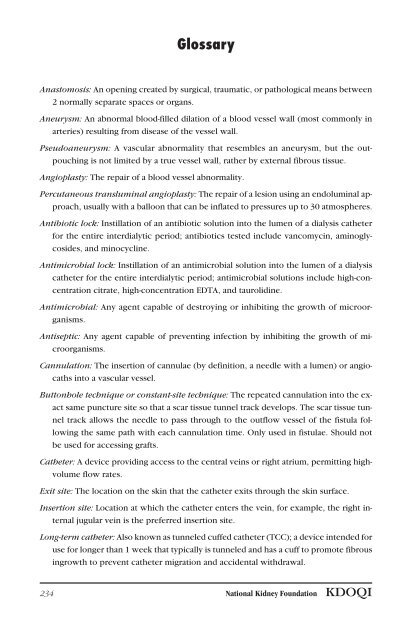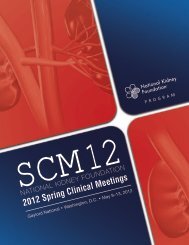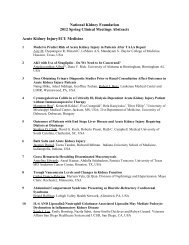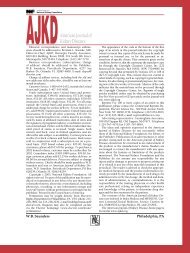2006 Updates Clinical Practice Guidelines and Recommendations
2006 Updates Clinical Practice Guidelines and Recommendations
2006 Updates Clinical Practice Guidelines and Recommendations
You also want an ePaper? Increase the reach of your titles
YUMPU automatically turns print PDFs into web optimized ePapers that Google loves.
Glossary<br />
Anastomosis: An opening created by surgical, traumatic, or pathological means between<br />
2 normally separate spaces or organs.<br />
Aneurysm: An abnormal blood-filled dilation of a blood vessel wall (most commonly in<br />
arteries) resulting from disease of the vessel wall.<br />
Pseudoaneurysm: A vascular abnormality that resembles an aneurysm, but the outpouching<br />
is not limited by a true vessel wall, rather by external fibrous tissue.<br />
Angioplasty: The repair of a blood vessel abnormality.<br />
Percutaneous transluminal angioplasty: The repair of a lesion using an endoluminal approach,<br />
usually with a balloon that can be inflated to pressures up to 30 atmospheres.<br />
Antibiotic lock: Instillation of an antibiotic solution into the lumen of a dialysis catheter<br />
for the entire interdialytic period; antibiotics tested include vancomycin, aminoglycosides,<br />
<strong>and</strong> minocycline.<br />
Antimicrobial lock: Instillation of an antimicrobial solution into the lumen of a dialysis<br />
catheter for the entire interdialytic period; antimicrobial solutions include high-concentration<br />
citrate, high-concentration EDTA, <strong>and</strong> taurolidine.<br />
Antimicrobial: Any agent capable of destroying or inhibiting the growth of microorganisms.<br />
Antiseptic: Any agent capable of preventing infection by inhibiting the growth of microorganisms.<br />
Cannulation: The insertion of cannulae (by definition, a needle with a lumen) or angiocaths<br />
into a vascular vessel.<br />
Buttonhole technique or constant-site technique: The repeated cannulation into the exact<br />
same puncture site so that a scar tissue tunnel track develops. The scar tissue tunnel<br />
track allows the needle to pass through to the outflow vessel of the fistula following<br />
the same path with each cannulation time. Only used in fistulae. Should not<br />
be used for accessing grafts.<br />
Catheter: A device providing access to the central veins or right atrium, permitting highvolume<br />
flow rates.<br />
Exit site: The location on the skin that the catheter exits through the skin surface.<br />
Insertion site: Location at which the catheter enters the vein, for example, the right internal<br />
jugular vein is the preferred insertion site.<br />
Long-term catheter: Also known as tunneled cuffed catheter (TCC); a device intended for<br />
use for longer than 1 week that typically is tunneled <strong>and</strong> has a cuff to promote fibrous<br />
ingrowth to prevent catheter migration <strong>and</strong> accidental withdrawal.<br />
234 National Kidney Foundation KDOQI
















